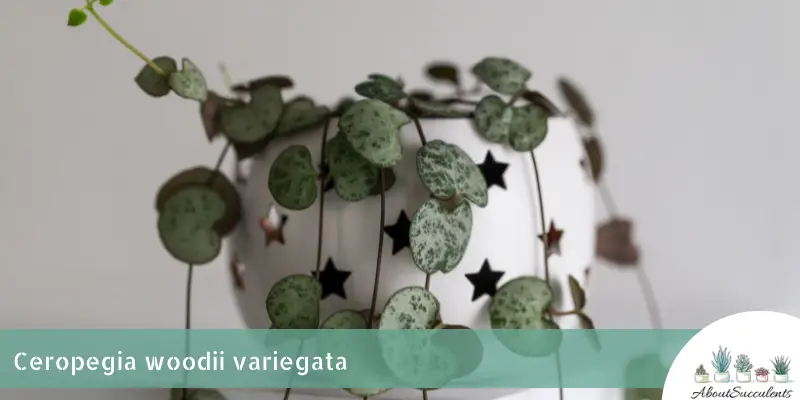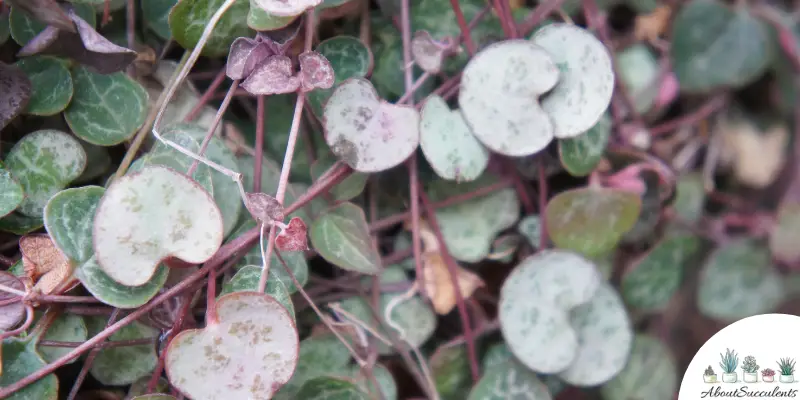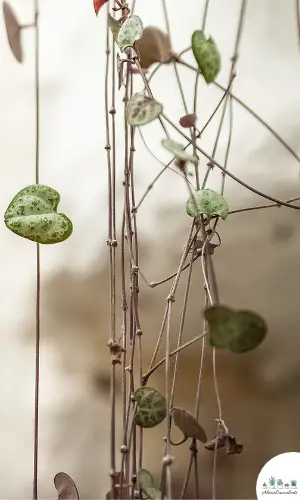
Ceropegia Woodii Variegata is an elegant trailing succulent that gives every home and garden a warm feeling of being one with nature.
The amount of praise this succulent has received can be inferred from its number of common names: String of Hearts, Sweetheart Vine, Hearts Entangled, Chain of Hearts, and Rosary Plant.
String of Hearts is a picture of contrasts: Delicate, heart-shaped, and variegated leaves that have sprouted from hard, wire-like stems. The variegated leaves can stop anyone in their tracks with deep green color and silver accents.
When given the proper amount of light, the leaves can develop a captivating hint of purplish color. This trailing plant can reach a length of 91cm (36”).
Sweetheart Vine is native to South Africa and is a member of the Asclepiadaceae family.
General Information
Also known as: String of Hearts, Sweetheart Vine, Hearts Entangled, Chain of Hearts, Rosary Plant
Plant Family: Asclepiadaceae
Origin: South Africa
Height: 91cm (36”)
Exposure: Full to partial sunlight for up to 4 hours.
Water Needs: Use the soak and dry method where the soil is allowed to dry completely before giving it a thorough watering.
Soil Type: Cactus mix with coarse sand added for better drainage.
Soil pH: 6.5
How to Grow and Care for Ceropegia Woodii Variegata

As with all plants, you need to give them the proper care for the best results. What makes succulents such as Ceropegia Woodii Variegata different is that the less you do, the better the results!
Sunlight
Ceropegia Woodii Variegata grows better when exposed to partial sunlight instead of full sunlight. For one, String of Hearts’ leaves will develop that much-sought-after purplish tint when the succulent is grown under low light conditions.
Sweetheart Vine doesn’t grow well under temperatures that go lower than 4.5° C (40° F).
If you live in a cold region that experiences these types of temperature drops, it would be a good idea to plant Hearts Entangled in a pot that can be moved inside your house.
As an addition to your outdoor succulent garden, Ceropegia Woodii Variegata will be very happy when it’s planted in an area that gets 4 to 6 hours of partial morning or late afternoon sun.
Thinking of growing Chain of Hearts as a houseplant? Place it near a window that receives up to 4 hours of indirect sunlight. If this isn’t possible during the winter, place the succulent under a Grow Light.
Watering

The great thing about growing String of Hearts is that if you forgot to water the soil while you’re on your way to a week-long vacation, you won’t have anything to worry about.
This is a durable type of succulent that grows better when watered with less frequency. To be sure, always check the dryness of the soil.
Only water the soil when you can guarantee that it’s 100% stone dry. Depending on the season, this could take anywhere from 7 to 10 days. Overwatering will lead to root rot and potentially kill your succulent plant.
The soil loses moisture during the summer months compared to winter. Expect to give the Rosary Plant less water when the months become colder.
You can check the moisture level simply by inserting a stick an inch or two into the soil. If the stick comes up dry, the soil is ready for watering.
Always water the soil and not from above. Make sure the soil gets a thorough soaking. When you see water coming out of the pot’s drain holes, the soil has received enough water.
Pot and Soil
House Ceropegia Woodii Variegata in an unglazed pot that’s made of either ceramic or terracotta material and has drain holes at the bottom. These types of potting materials allow moisture to escape easily from the soil.
The pot should be large enough to let the roots grow without getting entangled and to support the proper circulation of air within the soil.
The ideal type of soil is fresh, high-quality cactus mix because it’s known to have excellent drainage properties. To further improve drainage, add coarse sand.
How to Propagate Ceropegia Woodii Variegata
Ceropegia Woodii Variegata is not only an easy type of succulent to propagate but you have 3 methods to choose from: Stem Cuttings, Tubers, and Seeds.
Method 1 – Stem Cuttings
Step 1: With a sterilized and sharpened knife or garden shears, cut off a stem from the main plant.
Step 2: Place the stem cuttings in a dry and warm area where it can develop hard calluses in 2 to 3 days time.
Step 3: When the stem cuttings have enough hard calluses, plant them in fresh, high-quality cactus mix soil.
Step 4: Keep the soil lightly misted until the roots of the cuttings have formed.
Step 5: Once the roots have firmly taken hold of the soil, give it water only when the soil has dried out completely.
Method 2 – Tubers
Step 1: Rosary Plant grows “tubers”. These are short, thick pods that have seeds in them. Remove the tubers from the main plant. For best results, a part of the stem must be attached to the tuber.
Step 2: Plant the tubers into the soil. Keep the soil lightly moistened until the tubers have developed roots.
Step 3: Water the soil only when it’s 100% dry.
Method 3 – Seeds
Step 1: Buy String of Hearts seeds only from trusted nurseries.
Step 2: Plant the seeds in well-draining cactus mix soil.
Step 3: Lightly mist the soil to keep it moist, then cover it with plastic.
Step 4: Move the pot in a location that receives partial sunlight for up to 4 hours.
Step 5: When the roots have formed, remove the plastic and water the soil only when it has dried out.
Frequently Asked Questions
Is Ceropegia Woodii Variegata Toxic to Cats and Dogs?
Ceropegia Woodii Variegata is not included on the list of plants toxic to cats and dogs that appear on the website of the American Society for the Prevention of Cruelty to Animals (ASPCA).
Why Is My Ceropegia Woodii Variegata Dying?
Your Ceropegia Woodii Variegata could get weak or potentially die if it is given too much water and sunlight and if the plant gets infected by disease-carrying pests.
Overwatering
The leading cause of death for succulents is overwatering and String of Hearts is no exception.
When you give the soil more water than it needs, the roots are immersed in moisture for an extended period and in time, its cells will burst and expose it to infection.
This is often overlooked because the warning signs – discoloration – might not be noticeable.
If you see any part of the plant develop black spots or its color changes to a dark yellow or blackish hue, don’t take chances and act right away.
Get a pair of sterilized garden shears and cut off all the discolored parts. Once you’ve done this, shift your attention to the roots.
Remove the plant from the soil and inspect the roots. Cut off all the rotten ones and leave Sweetheart Vine in a warm area to dry out. Prepare a new pot with fresh cactus mix and replant Hearts Entangled.
Too Much Sunlight
Succulents need sunlight to produce food and to bring out their full color. For Ceropegia Woodii Variegata, giving it too much direct sunlight can lead to sunburn and scorch its leaves.
If you’re moving String of Hearts from the indoors to your garden, don’t expose it to full sunlight. Instead, start out by placing the succulent in an area with partial shade. Don’t exceed 4 hours of sun exposure and avoid the mid-afternoon rays.
Pest Infestation
Mealybugs, aphids, and scale insects are the usual trespassers. Once they’re nestled in, these pests will drink away Rosary Plant’s precious sap.
Mealybugs also leave white, powdery substances on the leaves that can develop into a fungal infection.
Wipe these substances off with a cotton swab that’s been dipped in 70% isopropyl alcohol and then spray Sweetheart Vine with an organic insecticide or neem oil.
Yes, Ceropegia Woodii Variegata produces tubular-shaped flowers that have a purplish-pink color in the summertime.
Last Updated on June 9, 2022 by Sofia Lara